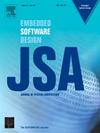Prism: An efficient file mapping mechanism across multiple namespaces in mobile systems
IF 4.1
2区 计算机科学
Q1 COMPUTER SCIENCE, HARDWARE & ARCHITECTURE
引用次数: 0
Abstract
Existing mobile operating systems, such as Android, employ a unidirectional file mapping model to share files across different components of the systems. For example, a real file stored in F2FS of the Kernel layer may be mapped to the abstract file system in the Framework layer and the distributed file system in the Application layer. In this model, the namespaces of the file systems in different layers maintain varied metadata for the same real file, with modifications only propagating from top to bottom. Thus, the metadata of a real file in different namespaces may be inconsistent once the underlying file systems updates the real file without notifying the mapping namespaces, leading to a “mapping invalidation” issue. In this paper, we construct a new bidirectional model for mapping files in mobile systems. Specifically, we design a mechanism called Prism to enable bidirectional file mapping among multiple namespaces transparently. The core idea is to introduce a Shared-Inode (SInode) structure in the system’s intermediate layer to manage shared essential metadata. Prism provides two synchronization modes, i.e., immediate synchronization mode and delayed synchronization mode, to update the metadata changes from the lower namespaces to the upper namespaces in different scenarios. We implement Prism in Android 13 and evaluate it with real applications. Extensive experimental results show that Prism effectively resolves the “mapping invalidation” issue, particularly for image re-compression tasks. Experimental results demonstrate that our design reduces CPU and memory overhead by nearly 50% compared to the original system while having a trivial impact on overall performance.
Prism:移动系统中跨多个名称空间的高效文件映射机制
现有的移动操作系统,如Android,采用单向文件映射模型在系统的不同组件之间共享文件。例如,存储在内核层F2FS中的真实文件可以映射到框架层的抽象文件系统和应用层的分布式文件系统。在这个模型中,不同层的文件系统的名称空间为同一个实际文件维护不同的元数据,修改只从上到下传播。因此,一旦底层文件系统在不通知映射名称空间的情况下更新了实际文件,则不同名称空间中实际文件的元数据可能不一致,从而导致“映射无效”问题。本文构造了一个新的移动系统中文件映射的双向模型。具体来说,我们设计了一种名为Prism的机制,以透明地支持多个名称空间之间的双向文件映射。其核心思想是在系统的中间层中引入一个shared - inode (SInode)结构来管理共享的基本元数据。Prism提供了两种同步模式,即即时同步模式和延迟同步模式,用于在不同场景下将元数据更改从底层命名空间更新到上层命名空间。我们在Android 13中实现了Prism,并在实际应用中对其进行了评估。大量的实验结果表明,Prism有效地解决了“映射无效”问题,特别是对于图像重压缩任务。实验结果表明,与原始系统相比,我们的设计减少了近50%的CPU和内存开销,同时对整体性能的影响很小。
本文章由计算机程序翻译,如有差异,请以英文原文为准。
求助全文
约1分钟内获得全文
求助全文
来源期刊

Journal of Systems Architecture
工程技术-计算机:硬件
CiteScore
8.70
自引率
15.60%
发文量
226
审稿时长
46 days
期刊介绍:
The Journal of Systems Architecture: Embedded Software Design (JSA) is a journal covering all design and architectural aspects related to embedded systems and software. It ranges from the microarchitecture level via the system software level up to the application-specific architecture level. Aspects such as real-time systems, operating systems, FPGA programming, programming languages, communications (limited to analysis and the software stack), mobile systems, parallel and distributed architectures as well as additional subjects in the computer and system architecture area will fall within the scope of this journal. Technology will not be a main focus, but its use and relevance to particular designs will be. Case studies are welcome but must contribute more than just a design for a particular piece of software.
Design automation of such systems including methodologies, techniques and tools for their design as well as novel designs of software components fall within the scope of this journal. Novel applications that use embedded systems are also central in this journal. While hardware is not a part of this journal hardware/software co-design methods that consider interplay between software and hardware components with and emphasis on software are also relevant here.
 求助内容:
求助内容: 应助结果提醒方式:
应助结果提醒方式:


